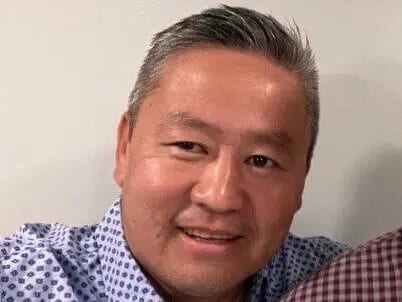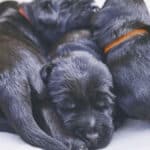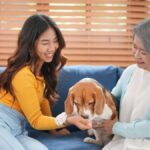Interview with Eduardo Fugiwara, Co-breeder of Rockledge Irish Terriers
Please tell us a little bit about yourself. Where do you live? What is your breed? What is your kennel name? Do you have a website? How long have you been in dogs? How long have you been breeding dogs? Who are some of your best-known dogs?
Eduardo Fugiwara: My name is Eduardo Fugiwara. I am the Vice-President of the Irish Terrier Club of America (ITCA) and Show Chair of our National Specialty, and Show Chair for South Dade Kennel Club in Florida. I am an AKC Delegate for the Two Cities Kennel Club in California, and an elected member of the AKC All-Breed Club Committee. I volunteer with a local 4-H, and our dog club program emphasizes animal husbandry.
I live in Hampton, New Jersey, on the top of a mountain. Our breed is the Irish Terrier, but I grew up with Doberman Pinschers in Brazil. I delivered my first Doberman litter when I was 12 years old. We got our first Irish Terrier back in 2012. We have been breeding Irish Terriers for eight years, and co-breed with Linda Honey under the Rockledge kennel. We do not have a website at this moment. Some of the dogs we have bred include MBIS MRBIS MBISS GCHG Rockledge Mr. Murphy Of Meath and MBIS MRBIS MBISS GCHB Rockledge Knock On Wood At Thornton’s.
As a Breeder, can you share your thoughts on your breed today? Is breed type strong? Are there things to be concerned about? Are there any health-related issues? Have you worked with breeders overseas? Are pet homes typically available for your breed?
Eduardo Fugiwara: Irish Terriers are a very unique terrier. In opposition to many long-legged terriers, our dogs should not be square. They should be longer than tall. It is common to see less knowledgeable judges choosing square dogs, which is not at all what an Irish Terrier should look like.
To paraphrase our Breed Standard: “The over-all appearance of the Irish Terrier is important. In conformation, he must be more than a sum of his parts. He must be all-of-a-piece, a balanced, vital picture of symmetry, proportion, and harmony.”
So, key words for Irish Terrier structure should be BALANCED, Symmetric, Proportional, and Harmonic. Remember, they are a farm dog that is meant to be working all day long. If he is not a sound and balanced dog, he cannot work all day. The Irish Terrier must be able to move freely and effortlessly.
General Appearance: “This terrier must be active, lithe and wiry in movement, with great animation; sturdy and strong in substance and bone structure, but at the same time free from clumsiness, for speed, power and endurance are most essential. The Irish Terrier must be neither ‘cobby’ nor ‘cloddy,’ but should be built on lines of speed with a graceful, racing outline.”
Irish Terriers are built in lines of speed with a graceful, racing outline. They must be racy!!! Never square.
We are lucky that breed type is present in most specimens, with the exception of a few very short-backed ones. But overall, we have a very small gene pool, and fortunately, we can still notice a strong breed type present in the rings.
Some of the concerns I have are regarding balance and soundness. As I’ve mentioned, a farm dog works all day long. They must be able to move well and effortlessly, which requires a nice and sound structure. So, I always believe soundness and balance, with a noticeable breed type, should be rewarded.
When it comes to health issues, cystinuria is present in our breed. The ITCA is actively trying to support a study to find a gene marker for our type 3 cystinuria.
We have worked with breeders overseas. We have worked with the Hagstroms (Merrymac) in Sweden, and we have a dog in Spain with Irene Arrizabalaga Atxaerandio (Betirish).
We have many pet homes around the country, and many of our puppies live in NYC and Brooklyn. We are very committed when it comes to temperament and raising puppies so that our puppies will be very well adjusted to living anywhere. We keep in touch with all of our owners and we also devote many hours to mentoring our companion homes too.
As an Exhibitor, can you comment on recent entries in your breed? Are majors available in your area? Does your breed often participate in Companion and Performance events? How can newcomers in your breed be encouraged to join the sport of dogs?
Eduardo Fugiwara: In our area, we have seen a huge growth in entries, mostly due to the fact that we work really hard to develop new show homes. In the past two years, we have over 10 new show homes. We meet weekly to work on grooming and ear setting, etc. I also have show homes in Canada and in other states. We try to work with them via Zoom and FaceTime. It is not uncommon at our local shows and specialties that our entries are almost half the total entry.
We have specialty shows in the second week of September, and the entry doubled from last year. We have majors in both dogs and bitches. A lot of our show homes are entered, many for the first time. Some of my companion homes are starting to engage in Companion and Performance events, so I am excited to see what will happen in the next few years.
Irish Terriers have very complex grooming needs. It takes some time to get proficient at hand-stripping. So, working with groups and grooming weekly together helps to give confidence to the newbies. I also help connect new show homes with professional handlers, either for grooming or for handling services. Many of the pro handlers have made some of my new show homes become engaged in Conformation.
In the Companion and Performance events, it is very important that the breeders help the new owners to find places and mentors to help them navigate the sport. Mentorship is a big part of the retainability of newcomers. Creating a positive and encouraging support system is fundamental to grow our sport.
What are the biggest challenges facing the dog show community as a whole and how can we address them? And finally, what are some of the positive changes you’ve seen in your breed and in the dog show community as a whole over the past decade?
Eduardo Fugiwara: Negativity and cynicism are some of our big enemies. It is really difficult to attract new people to join the sport when they are exposed to people always complaining and bashing our sport and the AKC. If you cannot do anything to improve our sport, at least don’t bash the organization and the people trying to work to make the sport better. We appreciate your opinion, but until you are ready to do something about it, you should keep it for yourself.
Be welcoming. If you see a new face, stop and say hello. You do not need to strike up conversations every time, but at least look at them and smile, and say hello. I know we are all busy and getting ready for our ring time, but at least smile and say hello. Acknowledgment makes people feel relevant. You can at least do that.
But if you are really into making a contribution to the sport, find a newbie and welcome them to your community. I promise you, it will make someone’s day very special, and they sure will want to come back again.
I urge the breeders to find mentors for your new show homes. They do not necessarily need to be in your breed. Sometimes it is easier if it’s a breed in a totally different Group. Connecting people before they go to their first show can be the difference between coming back next time, or dropping out of the sport.
I have seen people being more welcoming to newcomers in my breed. I would not be here if my mentors (and there are many of them) had not embraced Sean and I when we started. We met Linda through another Irish Terrier breeder, all because they included us in their activities during my first Montgomery week. I cannot believe this is our 10th year. Open your doors to newcomers. It can be risky, but so far, I have only seen the positive effects of the open-door policy. And in our experience, it has been worth the risk.
Now I will touch on a very sensitive issue, though many of my close friends do not agree with me about this, and it sure is very polemic.I have an issue with how some of the contracts are written as they were several decades before. I understand the proprietary issues with each other’s invaluable bloodlines, but if we want to get new people, the old requirements (one or two puppies back and other demands) are almost impossible for the aspiring dog fanciers to grasp.
My co-breeder does not believe in contracts, literally. We took that mentality and made our contracts reflect that our co-ownership does not give us any possession rights over the dogs. I keep my name on the bitches because, if I want to buy back a puppy, I will still be listed as breeder. I do not believe that if someone buys a bitch from me that they owe me a puppy back on top of the price of the bitch. I will be happy to pay for the puppy, as long as I am the breeder of record.
In order to move forward and become more attractive to the new generations, we must let go of some of our old concepts. Most people have a really hard time giving away the “control.” And it is very hard to do so, but one of the reasons that Linda, Sean, and I have a growing number of show homes is because we don’t try to control. We trust and offer the best guidance we can to our puppy homes. We accept the fact that once the puppies leave our homes they are not ours anymore. This mentality makes new show homes possible and makes our lives free of headaches.








